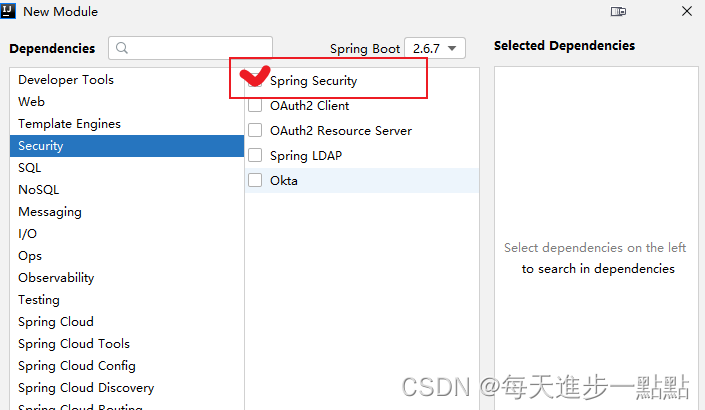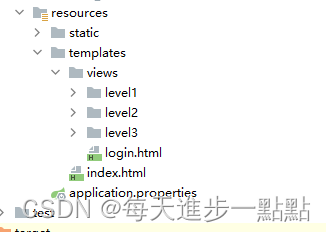一、系统安全
在Web开发中,我们在设计之初就需要考虑系统安全的方面,而不是把功能全部实现完成后,再去考虑。那样的话就会造成两难的境地:一方面,应用会存在严重的漏洞,无法满足用户需求,并可能造成用户信息被攻击者窃取;另一方面,应用的基本架构已经确定,想要修复安全漏洞,可能需要对系统做出较大的调整,因此,耗费大量的人力和物力,因此,我们应该从系统开始做的第一天就应该把安全策略考虑进去,并贯穿在整个应用开发过程中。
目前比较有名的框架有:Shiro,Spring Security
下面我们来了解并实践一下Spring Security
Spring Security官网:https://docs.spring.io/spring-security/site/docs/5.3.13.RELEASE
二、Spring Security简介
Spring Security是一个提供认证、授权和防止常见攻击的框架。
Spring Security 基于 Spring 框架,提供了一套 Web 应用安全性的完整解决方案。一般来说,Web 应用的安全性包括用户认证(Authentication)和用户授权(Authorization)两个部分。用户认证指的是验证某个用户是否为系统中的合法主体,也就是说用户能否访问该系统。用户认证一般要求用户提供用户名和密码。系统通过校验用户名和密码来完成认证过程。用户授权指的是验证某个用户是否有权限执行某个操作。在一个系统中,不同用户所具有的权限是不同的。比如对一个文件来说,有的用户只能进行读取,而有的用户可以进行修改。一般来说,系统会为不同的用户分配不同的角色,而每个角色则对应一系列的权限。
对于上面的情况Spring Security框架都有很好的支持。
在用户认证方面,Spring Security 框架支持主流的认证方式,包括 HTTP 基本认证、HTTP 表单验证、HTTP 摘要认证、OpenID 和 LDAP 等。在用户授权方面,Spring Security 提供了基于角色的访问控制和访问控制列表(Access Control List,ACL),可以对应用中的领域对象进行细粒度的控制。
三、案例
Spring Security 是针对Spring项目的安全框架,也是Spring Boot底层安全模块默认的技术选型,他可以实现强大的Web安全控制,对于安全控制,我们仅需要引入 spring-boot-starter-security 模块,进行少量的配置,即可实现强大的安全管理。
- WebSecurityConfigurerAdapter:自定义Security策略
- AuthenticationManagerBuilder:自定义认证策略
- @EnableWebSecurity:开启WebSecurity模式
Spring Security的两个主要目标是 “认证” 和 “授权”(访问控制)
“认证”(Authentication)
身份验证是关于验证您的凭据,如用户名/用户ID和密码,以验证您的身份。
“授权” (Authorization)
授权发生在系统成功验证您的身份后,最终会授予您访问资源(如信息,文件,数据库等)的完全权限。
1、新建模块

2、导入静态资源

3、编写控制器,实现跳转
@Controller
public class RouterController {
@RequestMapping({"/", "/index"})
public String index() {
return "index";
}
@RequestMapping("/toLogin")
public String toLogin() {
return "views/login";
}
@RequestMapping("/level1/{id}")
public String level1(@PathVariable("id") int id) {
return "views/level1/" + id;
}
@RequestMapping("/level2/{id}")
public String level2(@PathVariable("id") int id) {
return "views/level2/" + id;
}
@RequestMapping("/level3/{id}")
public String level3(@PathVariable("id") int id) {
return "views/level3/" + id;
}
}
4、安全功能实现
如果不加入认证和授权功能,我们写的应用是谁都可以访问的,因此我们需要使用Spring Security 增加上认证和授权的功能。
官方文件:https://docs.spring.io/spring-security/site/docs/5.2.15.RELEASE/reference/html5/#jc-authentication
认证和授权
1、编写配置类
protected void configure(AuthenticationManagerBuilder auth) throws Exception {
auth.inMemoryAuthentication().passwordEncoder(new BCryptPasswordEncoder())
.withUser("cwy").password(new BCryptPasswordEncoder().encode("123123")).roles("vip2","vip3")
.and()
.withUser("root").password(new BCryptPasswordEncoder().encode("123123")).roles("vip1","vip2","vip3")
.and()
.withUser("guest").password(new BCryptPasswordEncoder().encode("123123")).roles("vip1");
//There is no PasswordEncoder mapped for the id "null"
}
通过内存的方式 创建账户,并且给账户对应的授权角色
权限控制和注销
protected void configure(HttpSecurity http) throws Exception {
//首页所有人可以访问,功能页有相应权限才能访问
//链式编程
//请求授权的规则
http.authorizeRequests()
.antMatchers("/").permitAll()
.antMatchers("/level1/**").hasRole("vip1")
.antMatchers("/level2/**").hasRole("vip2")
.antMatchers("/level3/**").hasRole("vip3");
为每一个访问请求分配访问权限,限制用户角色访问。这就是权限控制。
注销功能实现起来也非常简单
//注销功能
http.logout().logoutSuccessUrl("/login");
在index页面
<!--注销-->
<a class="item" th:href="@{/logout}">
<i class="sign-out icon"></i> 注销
</a>
注销后返回登入页面
记住我
//开启记住我功能
http.rememberMe().rememberMeParameter("remember" );
在登入界面中
<div class="field">
<input type="checkbox" name="remember">记住我
</div>
<input type="submit" class="ui blue submit button"/>
记住我功能就是利用cookies来实现的
完整配置类
@EnableWebSecurity
public class SecurityConfig extends WebSecurityConfigurerAdapter {
/**
* 授权的
* @param http
* @throws Exception
*/
@Override
protected void configure(HttpSecurity http) throws Exception {
//首页所有人可以访问,功能页有相应权限才能访问
//请求授权的规则
http.authorizeRequests()
.antMatchers("/").permitAll()
.antMatchers("/level1/**").hasRole("vip1")
.antMatchers("/level2/**").hasRole("vip2")
.antMatchers("/level3/**").hasRole("vip3");
//没有权限,默认到登录页面
http.formLogin().loginPage("/tologin").usernameParameter("user").passwordParameter("pwd").loginProcessingUrl("/login");
//防止网站攻击
http.csrf().disable();关闭csrf功能:跨站请求伪造,默认只能通过post方式提交logout请求
//注销功能
http.logout().logoutSuccessUrl("/login");
//开启记住我功能
http.rememberMe().rememberMeParameter("remember" );
}
/**
* 认证的
* @param auth
* @throws Exception
*/
@Override
protected void configure(AuthenticationManagerBuilder auth) throws Exception {
//在内存中定义,也可以再jdbc拿数据
auth.inMemoryAuthentication().passwordEncoder(new BCryptPasswordEncoder())
.withUser("cwy").password(new BCryptPasswordEncoder().encode("123123")).roles("vip2","vip3")
.and()
.withUser("root").password(new BCryptPasswordEncoder().encode("123123")).roles("vip1","vip2","vip3")
.and()
.withUser("guest").password(new BCryptPasswordEncoder().encode("123123")).roles("vip1");
//There is no PasswordEncoder mapped for the id "null"
}
}
我们需要结合thymeleaf中的一些功能
sec:authorize=“isAuthenticated()”:是否认证登录!来显示不同的页面






















 924
924











 被折叠的 条评论
为什么被折叠?
被折叠的 条评论
为什么被折叠?








